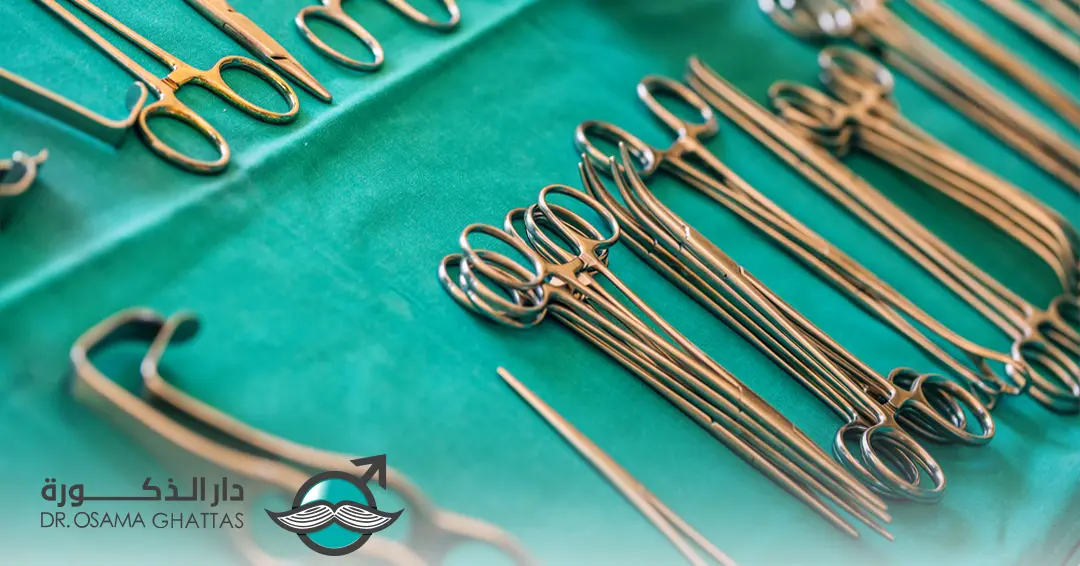Covering surgical tools (dilators, retractors, etc.) with gold [specifically in the setting of penile implant surgery for ED].
Background:
Penile prosthesis implantation carries a high risk of infection, and rigorous infection control measures are critical to reducing complications.
Pros:
- Biocompatibility:
– Gold is highly inert and non-reactive, reducing the risk of allergic or inflammatory reactions, though this is more critical for implanted materials than temporary surgical tools. - Corrosion Resistance:
– Gold is extremely resistant to corrosion and tarnish, which could help maintain tool integrity over time, especially with repeated sterilization cycles (Beneficial for the surgeon, not the patient?). - Smooth Surface:
– Gold plating can create a smooth, low-friction surface, which might make instruments like dilators and sizers glide more easily within tissue, potentially reducing trauma or micro-tears during corporal dilation (While it is theoretically plausible that gold plating could create a smooth, low-friction surface, facilitating easier glide of instruments like dilators and sizers within tissue, this benefit is likely overstated. Modern surgical tools are already crafted from highly polished stainless steel or titanium, which are designed to minimize friction and tissue trauma. Moreover, the primary factors influencing trauma during corporal dilation are the force applied, surgical technique, and the inherent fibrous nature of the corpora cavernosa, rather than micro-level differences in surface smoothness. Gold, being a relatively soft metal, is also prone to micro-scratches and wear over time, particularly with repeated sterilization and mechanical use, which may degrade any initial smoothness and expose the underlying material. Additionally, effective lubrication with sterile gels typically plays a much more critical role in reducing friction than the surface coating alone. There is also a theoretical concern that an overly slick surface might reduce tactile feedback for the surgeon, potentially complicating delicate maneuvers. Without evidence showing that gold plating leads to measurable improvements in clinical outcomes or reductions in complications, the added cost and maintenance challenges may not be justified.) - Antimicrobial Potential:
– While not as potent as silver, there is some theoretical antimicrobial benefit with gold, especially in nanoparticle form. However, this is minimal with bulk gold plating. - Visibility:
– The bright gold colour may improve visibility of tools in the surgical field, helping differentiate instruments quickly, though this is a minor advantage.
Cons:
- Cost:
– Gold is expensive, and coating large or multiple instruments (like a full set of dilators and retractors) would add substantial cost without strong evidence of clinical benefit. - Softness and Durability:
– Gold is soft and prone to wear, scratches, and denting. For high-stress tools like dilators and sizers—especially those inserted and rotated within tough tissue—this softness could lead to premature degradation of the coating. - No Proven Added Clinical Benefit:
– Despite gold’s inertness, stainless steel and titanium instruments already offer excellent biocompatibility, corrosion resistance, and durability. There’s no clinical evidence that gold-coated tools improve outcomes (e.g., reduce infection rates or complications) in penile implant surgery. - Sterilization Issues:
– Gold can withstand standard sterilization but is more prone to surface damage if abrasively cleaned or if the plating is thin and wears down over time. - Risk of Flaking/Particles:
– If the gold coating wears or flakes off during use, gold particles could enter tissue planes, although this risk is small with high-quality plating. Still, any foreign particles left behind can be undesirable. - In the context of penile implant surgery:
-This type of surgery relies on precision and atraumatic handling, but it’s typically performed using high-grade stainless-steel tools that already meet these needs reliably. The infection prevention strategies focus more on:
– Antibiotic prophylaxis.
– Hydrophilic or antibiotic-coated implants.
– Meticulous sterile technique.
– Thus, covering tools in gold is unlikely to add significant benefit but would introduce higher cost, durability concerns, and potential regulatory hurdles if marketed as a new product.
Current evidence:
- Currently, there is very limited to no direct evidence supporting the use of gold-coated surgical tools—like dilators, sizers, or retractors—in penile implant surgery or, more broadly, in urologic surgeries.
- What is available in the literature mostly relates to:
– Implantable devices (not surgical tools) that are coated with gold or other noble metals, aimed at reducing infection or improving biocompatibility.
– General biomedical materials science research, where gold’s properties (like being inert, antimicrobial in nanoparticle forms, or anti-corrosive) are explored, mostly in implants, catheters, or stents.
– A PubMed or major urology journal search (e.g., Journal of Urology, Urology, Sexual Medicine Reviews) doesn’t yield evidence showing clinical trials, cohort studies, or even significant case series evaluating gold-coated surgical tools for penile implants.
Related (but indirect) evidence areas:
- Gold in dentistry: Dental tools and implants have historically used gold due to its corrosion resistance and biocompatibility, but even in that field, cost and durability concerns have led to other materials becoming standard.
- Orthopedic implants: A few studies look at gold-coated orthopedic implants, aiming to reduce inflammatory responses and infections. But these are about long-term implants, not surgical instruments.
- Gold nanoparticles: There’s ongoing research into gold nanoparticles for antimicrobial coatings (e.g., on catheters), but again, that’s not directly about large surgical tools.
Conclusion:
- There’s no clinical data specifically evaluating gold-plated surgical instruments (like dilators or retractors) in penile prosthesis surgery for outcomes like infection reduction, tissue trauma, or healing.
- The standard of care remains stainless steel or titanium tools, which have excellent long-term track records and FDA/CE approvals.
- So while gold might seem attractive theoretically, it’s unproven in this specific setting, and introducing gold-plated surgical tools would need new studies or trials to justify the cost and potential regulatory approval.
References:
- Aminabad, Negar Sedghi, Masoud Farshbaf, and Abolfazl Akbarzadeh. “Recent advances of gold nanoparticles in biomedical applications: state of the art.” Cell biochemistry and biophysics 77 (2019): 123-137.
- Asri, R. I. M., W. S. W. Harun, M. Samykano, N. A. C. Lah, S. A. C. Ghani, F. Tarlochan, and M. R. Raza. “Corrosion and surface modification on biocompatible metals: A review.” Materials Science and Engineering: C 77 (2017): 1261-1274.
- Eliaz, Noam. “Corrosion of metallic biomaterials: A review.” Materials 12, no. 3 (2019): 407.
- Rai, Maharashtra K., S. D. Deshmukh, A. P. Ingle, and A. K. Gade. “Silver nanoparticles: the powerful nanoweapon against multidrug‐resistant bacteria.” Journal of applied microbiology112, no. 5 (2012): 841-852.
- Cavayero, Chase T., Stephen W. Leslie, and Gregory V. McIntosh. “Penile prosthesis implantation.” In StatPearls [Internet]. StatPearls Publishing, 2024.
- Gross, Martin S., Elizabeth A. Phillips, Robert J. Carrasquillo, Amanda Thornton, Jason M. Greenfield, Laurence A. Levine, Joseph P. Alukal et al. “Multicenter investigation of the micro-organisms involved in penile prosthesis infection: an analysis of the efficacy of the AUA and EAU guidelines for penile prosthesis prophylaxis.” The Journal of Sexual Medicine 14, no. 3 (2017): 455-463.
- Blum, Michael D. “Infections of genitourinary prostheses.” Infectious Disease Clinics of North America 3, no. 2 (1989): 259-274.
- Dikici, Burak, Ziya Esen, Ozgur Duygulu, and Serap Gungor. “Corrosion of metallic biomaterials.” Advances in Metallic Biomaterials: Tissues, Materials and Biological Reactions(2015): 275-303.
- Singh, Raghuvir, and Narendra B. Dahotre. “Corrosion degradation and prevention by surface modification of biometallic materials.” Journal of Materials Science: Materials in Medicine 18, no. 5 (2007): 725-751.
- Kelly, J. Robert. “Dental ceramics: what is this stuff anyway?.” The Journal of the American Dental Association 139 (2008): S4-S7.
- Alt, Volker, Thorsten Bechert, Peter Steinrücke, Michael Wagener, Peter Seidel, Elvira Dingeldein, Eugen Domann, and Reinhard Schnettler. “An in vitro assessment of the antibacterial properties and cytotoxicity of nanoparticulate silver bone cement.” Biomaterials 25, no. 18 (2004): 4383-4391.


